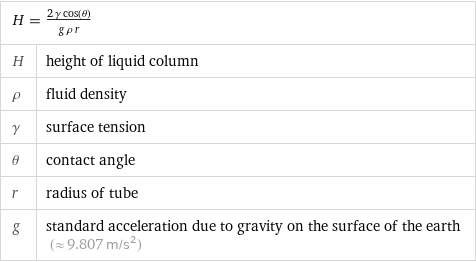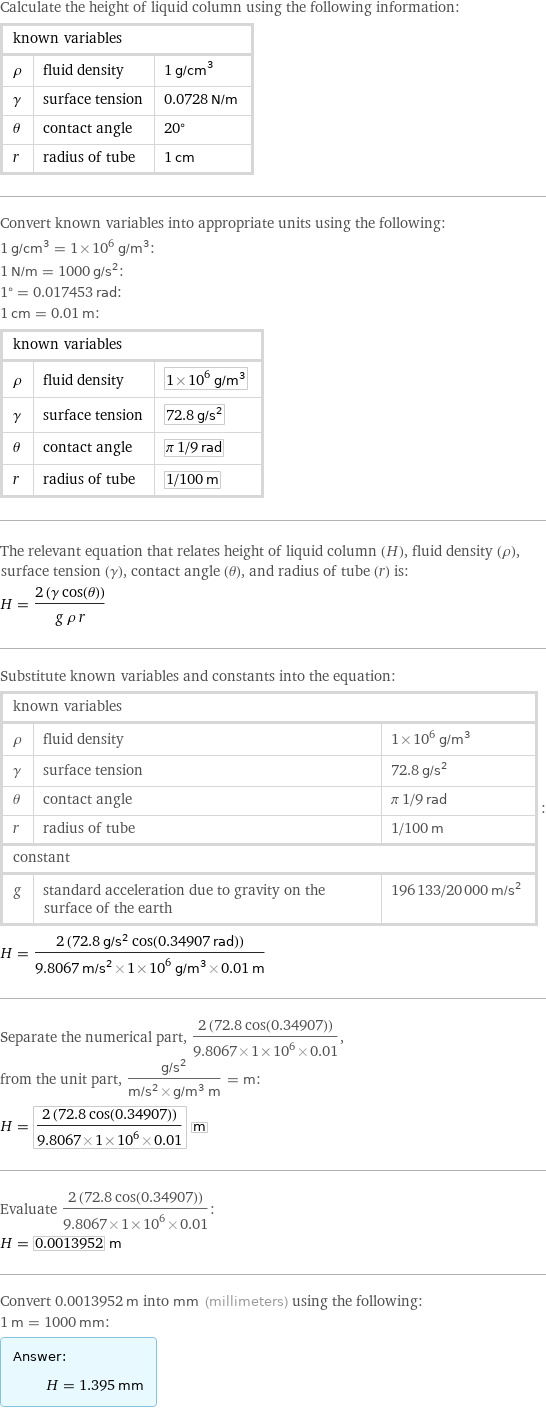Input interpretation

capillary action
Equation

H = (2 γ cos(θ))/(g ρ r) | H | height of liquid column ρ | fluid density γ | surface tension θ | contact angle r | radius of tube g | standard acceleration due to gravity on the surface of the earth (≈ 9.807 m/s^2)
Units

Input values

fluid density | water (density): 1 g/cm^3 (gram per cubic centimeter) surface tension | 0.0728 N/m (newtons per meter) contact angle | 20° (degrees) radius of tube | 1 cm (centimeter)
Results

height of liquid column | 1.395 mm (millimeters) = 0.05493 inches = 0.1395 cm (centimeters) = 0.001395 meters
Possible intermediate steps

Calculate the height of liquid column using the following information: known variables | | ρ | fluid density | 1 g/cm^3 γ | surface tension | 0.0728 N/m θ | contact angle | 20° r | radius of tube | 1 cm Convert known variables into appropriate units using the following: 1 g/cm^3 = 1×10^6 g/m^3: 1 N/m = 1000 g/s^2: 1° = 0.017453 rad: 1 cm = 0.01 m: known variables | | ρ | fluid density | 1×10^6 g/m^3 γ | surface tension | 72.8 g/s^2 θ | contact angle | π 1/9 rad r | radius of tube | 1/100 m The relevant equation that relates height of liquid column (H), fluid density (ρ), surface tension (γ), contact angle (θ), and radius of tube (r) is: H = (2 (γ cos(θ)))/(g ρ r) Substitute known variables and constants into the equation: known variables | | ρ | fluid density | 1×10^6 g/m^3 γ | surface tension | 72.8 g/s^2 θ | contact angle | π 1/9 rad r | radius of tube | 1/100 m constant | | g | standard acceleration due to gravity on the surface of the earth | 196133/20000 m/s^2 | : H = (2 (72.8 g/s^2 cos(0.34907 rad)))/(9.8067 m/s^2×1×10^6 g/m^3×0.01 m) Separate the numerical part, (2 (72.8 cos(0.34907)))/(9.8067×1×10^6×0.01), from the unit part, (g/s^2)/(m/s^2×g/m^3 m) = m: H = (2 (72.8 cos(0.34907)))/(9.8067×1×10^6×0.01) m Evaluate (2 (72.8 cos(0.34907)))/(9.8067×1×10^6×0.01): H = 0.0013952 m Convert 0.0013952 m into mm (millimeters) using the following: 1 m = 1000 mm: Answer: | | H = 1.395 mm